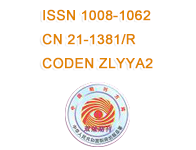目的:利用HR-MRI全面探究症状性基底动脉粥样硬化患者的动脉重塑(包括局灶性及普遍性)特点。方法:回顾性纳入行HR-MRI的症状性基底动脉(Basilar artery,BA)粥样硬化患者,根据BA供血区有无梗死分为两组,应用3D-VIAST成像,测量并比较组间患者斑块及管壁特征,包括斑块负荷、斑块面积、管周面积、局灶性重塑类型、斑块强化程度等;且纳入BA无斑块无梗死患者为正常对照,比较三组间BA管周面积及BA直径来观察BA普遍性重塑差异。结果:BA梗死组12例(斑块数:19),BA无梗死组15例(斑块数:18)及正常组17例;正性重塑在BA梗死组中占比较大(63%),且狭窄率大于BA无梗死组(P=0.029),组间斑块强化程度无差异;根据局灶性重塑分组,正性重塑组斑块面积及斑块负荷均大于非正性重塑组(P<0.05);症状性BA斑块两组BA管周面积及BA直径均大于正常对照(P<0.05),而症状性BA斑块组间上述两个指标无差异。结论:症状性梗死组BA斑块存在以正性重塑为主的局灶性重塑,症状性BA粥样硬化患者BA均存在普遍性扩张重塑。
Abstract
Objective: Using HR-MRI to explore the characteristics of arterial remodeling(including topical and general) in patients with symptomatic basilar atherosclerosis. Methods: Patients with symptomatic basilar atherosclerosis who were included in HR-MRI were divided into two groups according to whether there was infarction in the blood supply area of basilar artery (BA). 3D-VIAST T1WI imaging was used to measure and compare the plaque and wall characteristics of the patients, including plaque burden, plaque area, perivascular area, topical remodeling type and plaque enhancement degree, etc. Patients with plaque but without infarction were normal controls. The BA area and BA diameter were compared among the three groups to observe the difference of BA general remodeling. Results: There were 12 patients in the BA infarction group(plaque number: 19), 15 patients without BA infarction(plaque number: 18) and 17 patients in the normal group; positive remodeling accounted for a large proportion(63%) in the BA infarction group, and the stenosis rate was greater than that of the BA non-infarction group(P=0.029), and there was no difference in the degree of plaque enhancement among the groups; According to the topical remodeling group, the plaque area and plaque burden of the positive remodeling group were larger than those of the non-positive remodeling group(P<0.05). The area and diameter of BA in symptomatic BA plaque groups were larger than those in control group(P<0.05), but there was no difference between the two indicators in the symptomatic BA plaque groups. Conclusion: In symptomatic infarct group, positive remodeling was the main local remodeling of BA plaque, and there was general expansion remodeling in BA of symptomatic BA atherosclerosis.
关键词
基底动脉 /
动脉硬化 /
磁共振成像
Key words
Basilar artery /
Arteriosclerosis /
Magnetic resonance imaging
{{custom_sec.title}}
{{custom_sec.title}}
{{custom_sec.content}}
参考文献
[1]de Havenon A, Mossa-Basha M, Shah L, et al. High-resolution vessel wall MRI for the evaluation of intracranial atherosclerotic disease[J]. Neuroradiology, 2017, 59(12): 1193-1202.
[2]Wang Y, Zhao X, Liu L, et al. Prevalence and Outcomes of Symptomatic Intracranial Large Artery Stenoses and Occlusions in China[J]. Stroke, 2014, 45(3): 663-669.
[3]Feng C, Hua T, Xu Y, et al. Arterial remodeling of basilar atherosclerosis in isolated pontine infarction[J]. Neurol Sci, 2015, 36(4): 547-551.
[4]Glagov S, Weisenberg E, Zarins CK, et al. Compensatory enlargement of human atherosclerotic coronary arteries[J]. New Engl J Med, 1987, 316(22): 1371-1375.
[5]Rodriguez-Granillo GA. Coronary artery remodelling is related to plaque composition[J]. Heart, 2005, 92(3): 388-391.
[6]Birnbaum Y, Fishbein MC, Luo H, et al. Regional Remodeling of Atherosclerotic Arteries: A Major Determinant of Clinical Manifestations of Disease[J]. JACC, 1997, 30(5): 1149-1164.
[7]Ma N, Jiang WJ, Lou X, et al. Arterial remodeling of advanced basilar atherosclerosis: a 3-tesla MRI study[J]. Neurology, 2010, 75(3): 253-258.
[8]李焰生. 中国后循环缺血的专家共识[J]. 中华内科杂志,2006,45(9):786-787.
[9]Zhu X, Liu L, He X, et al. Wall thickening pattern in atherosclerotic basilar artery stenosis[J]. Neurol Sci, 2016, 37(2): 269-276.
[10]Qiao Y, Anwar Z, Intrapiromkul J, et al. Patterns and Implications of Intracranial Arterial Remodeling in Stroke Patients[J]. Stroke, 2016, 47(2): 434-440.
[11]Lee HN, Ryu CW, Yun SJ. Vessel-Wall Magnetic Resonance Imaging of Intracranial Atherosclerotic Plaque and Ischemic Stroke: A Systematic Review and Meta-Analysis[J]. Front Neurol, 2018, 9(1032): 1-13.
[12]Chung GH, Kwak HS, Hwang SB, et al. High resolution MR imaging in patients with symptomatic middle cerebral artery stenosis[J]. Eur J Radiol, 2012, 81(12): 4069-4074.
[13]Pasterkamp G, Schoneveld AH, van der Wal AC, et al. Relation of arterial geometry to luminal narrowing and histologic markers for plaque vulnerability: the remodeling paradox[J]. JACC, 1998, 32(3): 655-662.
[14]Celletti FL, Waugh JM, Amabile PG, et al. Vascular endothelial growth factor enhances atherosclerotic plaque progression[J]. Nat Med, 2001, 7(4): 425-429.
[15]Calcagno C, Cornily JC, Hyafil F, et al. Detection of neovessels in atherosclerotic plaques of rabbits using dynamic contrast enhanced MRI and 18F-FDG PET[J]. Arterioscler Thromb Vasc Biol, 2008, 28(7): 1311-1317.
[16]Huang J, Jiao S, Zhao X, et al. Characteristics of patients with enhancing intracranial atherosclerosis and association between plaque enhancement and recent cerebrovascular ischemic events: a high-resolution magnetic resonance imaging study[J]. Acta Radiol, 2019, 60(10): 1301-1307.
[17]Gupta A, Baradaran H, Al-Dasuqi K, et al. Gadolinium Enhancement in Intracranial Atherosclerotic Plaque and Ischemic Stroke: A Systematic Review and Meta-Analysis[J]. J Am Heart Assoc, 2016, 5(8): 1-14.
[18]Wu W, Guan Y, Xu K, et al. Plasma Homocysteine Levels Predict the Risk of Acute Cerebral Infarction in Patients with Carotid Artery Lesions[J]. Mol Neurobiol, 2016, 53(4): 2510-2517.
[19]Lu SS, Xie J, Su CQ, et al. Plasma homocysteine levels and intracranial plaque characteristics: association and clinical relevance in ischemic stroke[J]. BMC Neurol, 2018, 18(1): 200-207.
[20]Lee WJ, Choi HS, Jang J, et al. Non-stenotic intracranial arteries have atherosclerotic changes in acute ischemic stroke patients: a 3T MRI study[J]. Neuroradiology, 2015, 57(10): 1007-1013.
[21]Tanaka M, Sakaguchi M, Miwa K, et al. Basilar artery diameter is an independent predictor of incident cardiovascular events[J]. Arterioscler Thromb Vasc Biol, 2013, 33(9): 2240-2244.
基金
2017年陕西省人民医院科技发展孵化基金项目(2017YX-05)。


